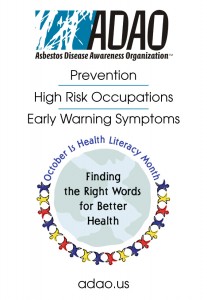Posted on October 22, 2012
3-Part Blog Series about Health Literacy
Part One: How Can You Prevent Home, School, and Workplace Asbestos Exposure? (Oct 8)
Part Two: What Are the High-Risk Occupations for Asbestos Exposure? (Oct 15)
Part Three: What Are the Early Warning Symptoms of Asbestos Disease? (Oct 22)
Today, we’re pleased to conclude our three-part blog series about health literacy. The series has been a tremendous success. Thank you for sharing the blogs with your loved ones. Until we discover a cure, education is the only way to end asbestos-caused diseases.
According to the U.S. Department of Health and Human Services, nearly 9 out of 10 adults have difficulty using the everyday health information that is routinely available to them. To address this problem, October is Health Literacy Month. In light of Health Literacy Month’s “Take Action” theme this year, ADAO is featuring three weekly blogs with information about preventing asbestos exposure (Oct 8), high-risk occupations (Oct 15), and early warning symptoms of asbestos disease (Oct 22). These blogs address the frequently asked questions that we have received during the last nine years. Unfortunately, asbestos is still legal and lethal in the U.S.; the U.S. Geological Survey reported that the U.S. consumed 1,180 metric tons of asbestos in 2011 “to meet manufacturing needs.”
Asbestos exposure is linked to asbestosis, lung and gastrointestinal cancers, and an aggressive cancer called mesothelioma. Inhaling asbestos fibers can cause permanent and irreversible damage to vital organs. Typically, disease occurs 10 – 50 years after exposure. Early detection is often difficult; asbestos-related disease symptoms are generally vague and can be easily confused with other illnesses, such as pneumonia. Only a doctor can properly diagnose asbestos-related diseases. Your doctor will ask you about possible occupational or environmental asbestos exposure.
According to the National Cancer Institute, you should contact your doctor immediately if you experience any of the following symptoms:
- A persistent cough that gets worse over time
- Blood in the sputum (fluid) coughed up from the lungs
- Pain or tightening in the chest
- Difficulty swallowing
- Swelling of the neck or face
- Loss of appetite
- Weight loss
- Fatigue or anemia
The above symptom list is from the National Cancer Institute Fact Sheet “Asbestos Exposure and Cancer Risk.” Please note, however, that not all asbestos exposure or disease leads to cancer.
Important Notice: ADAO does not make medical diagnoses, recommend treatment, or answer specific patient questions. Specific concerns should be addressed directly by your treating physician.
Also, don’t forget to Take Action during Health Literacy Month by completing ADAO’s Online Mesothelioma Survey. It only takes five minutes to share your recommendations, knowledge and experience. Click here to complete the “Supportive Resources in the Mesothelioma Community” Survey!
Together, change is possible.
Linda
Linda Reinstein’s Social Networks
ADAO’s Social Networks
For more information, click on any of the graphics below.
|
|
|
|
|
|
|



